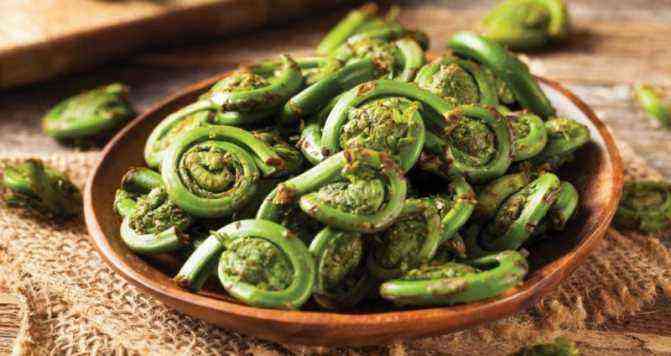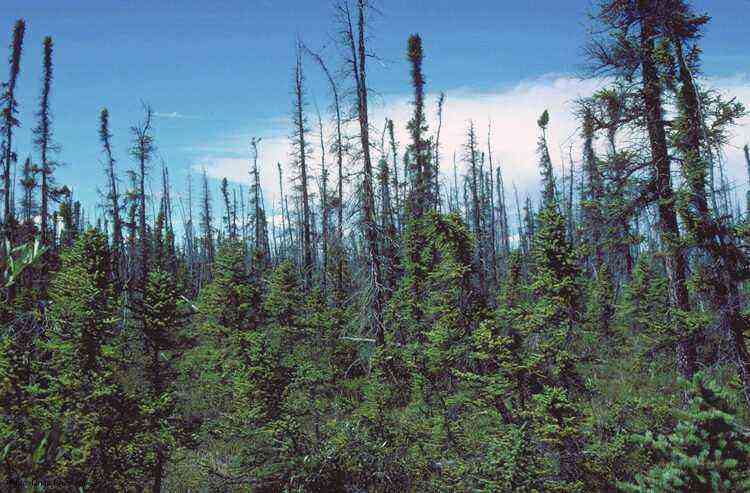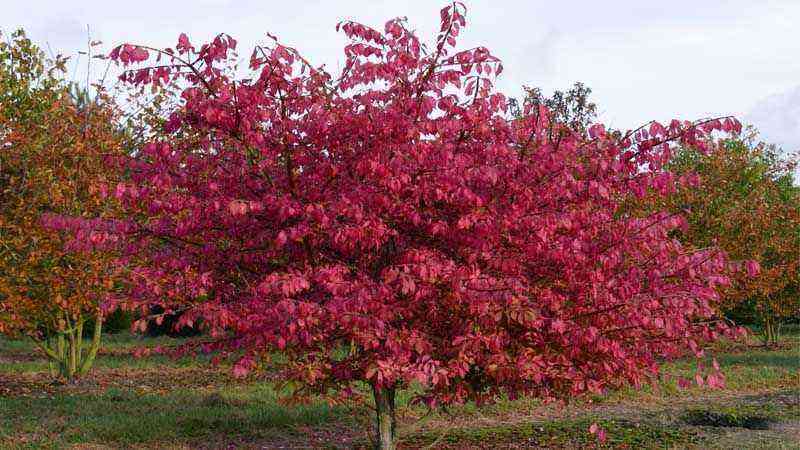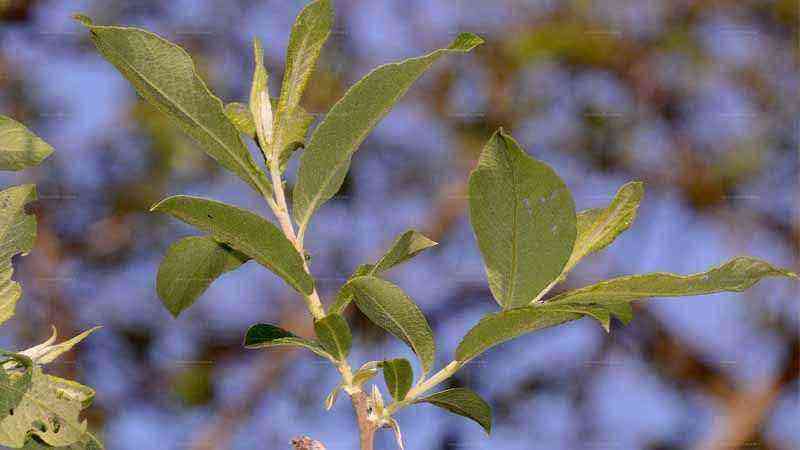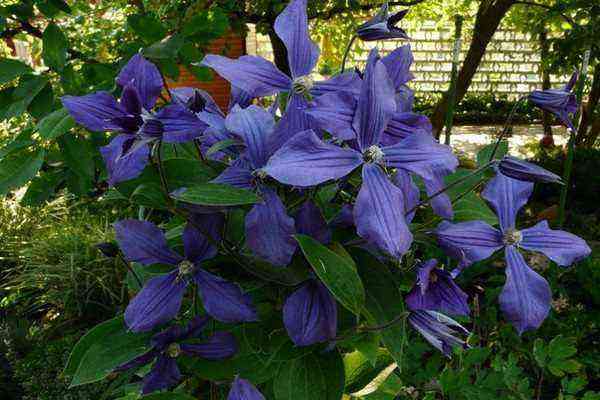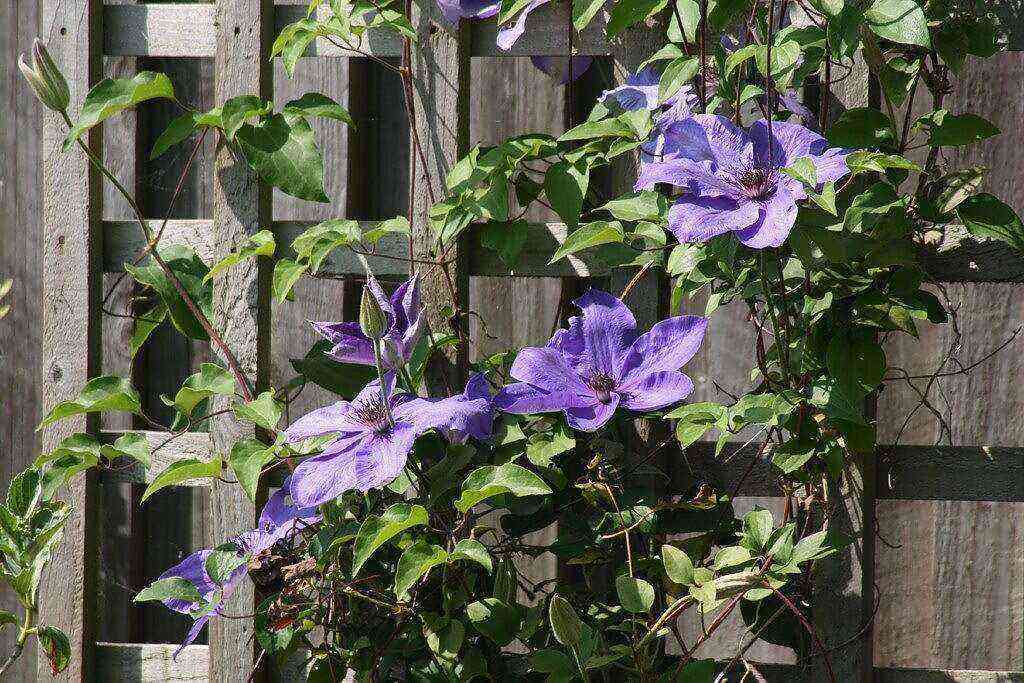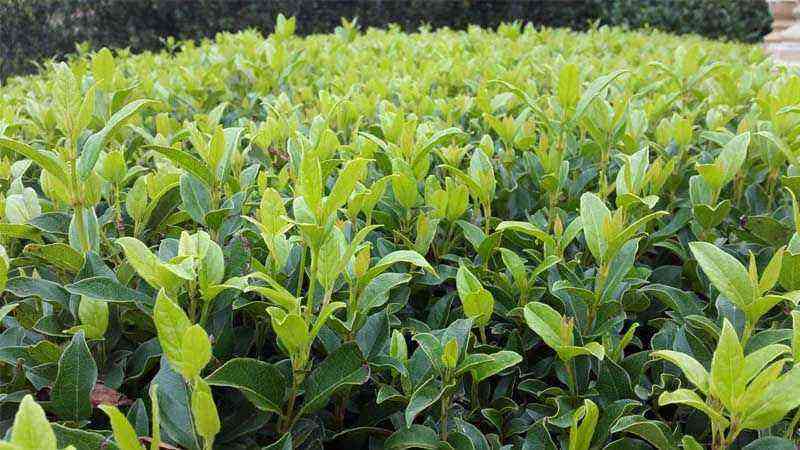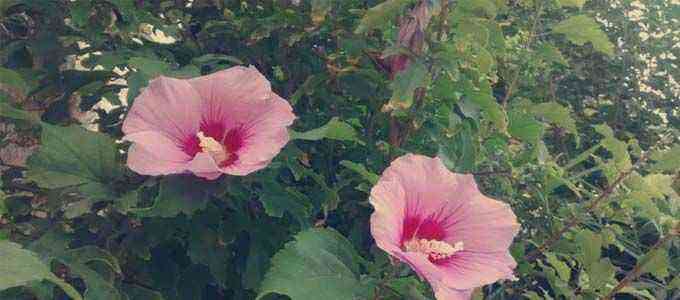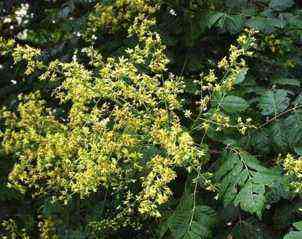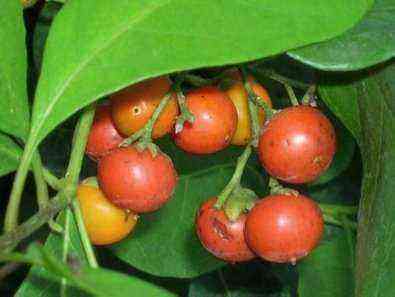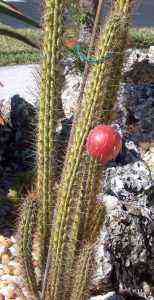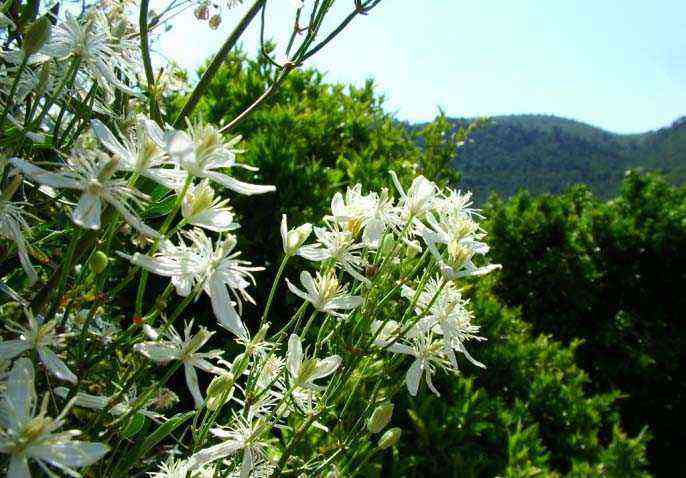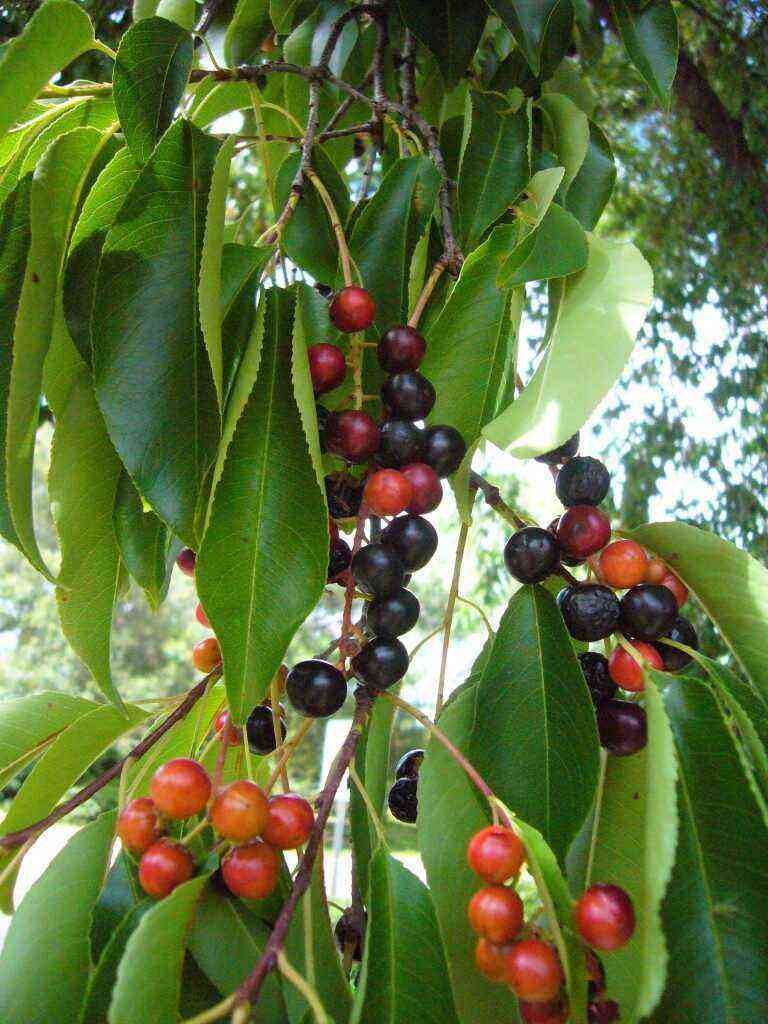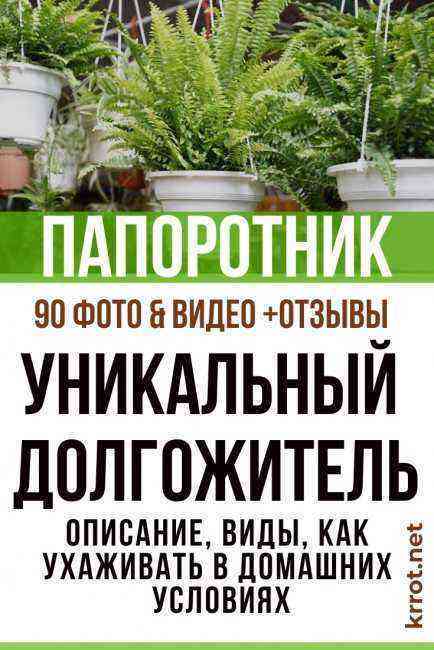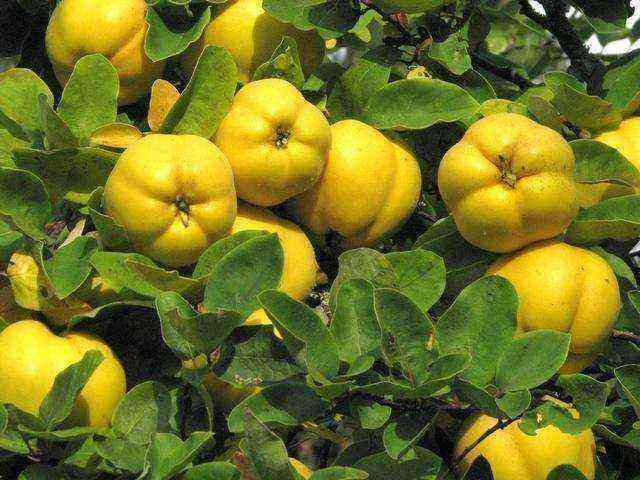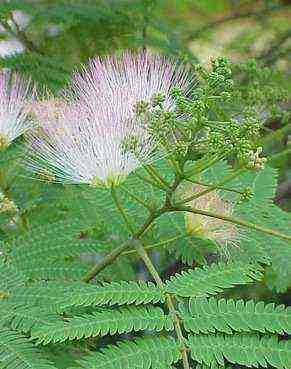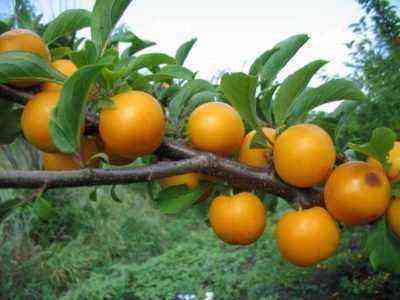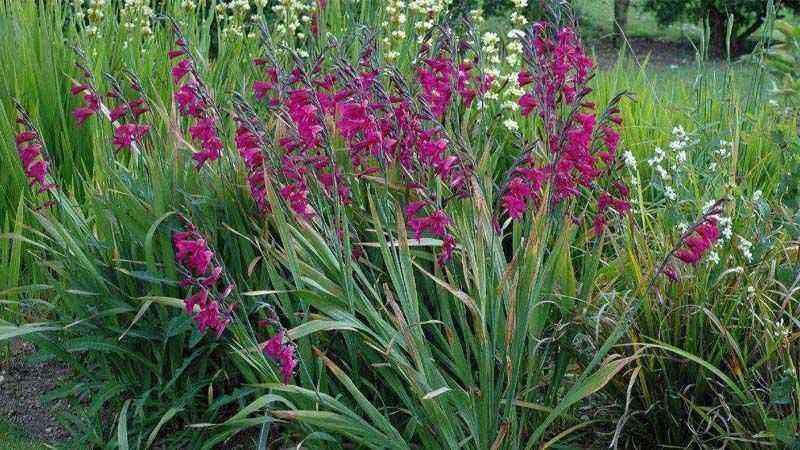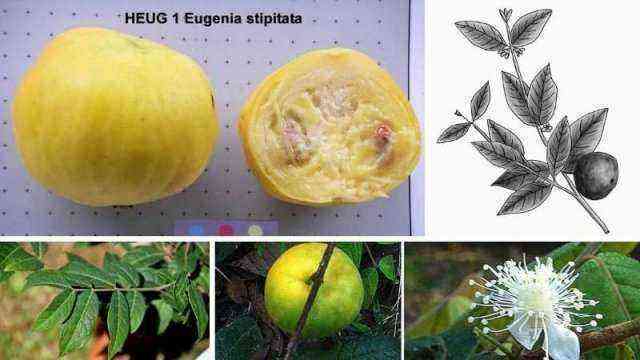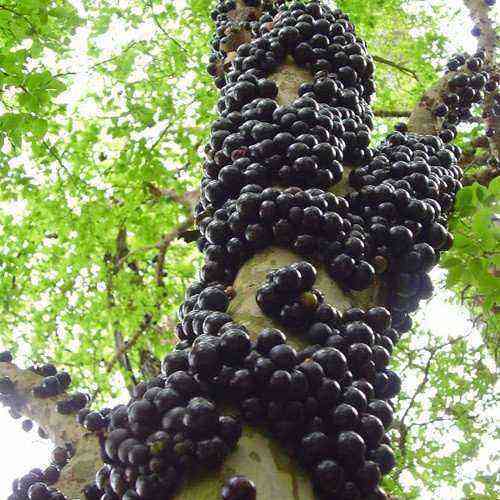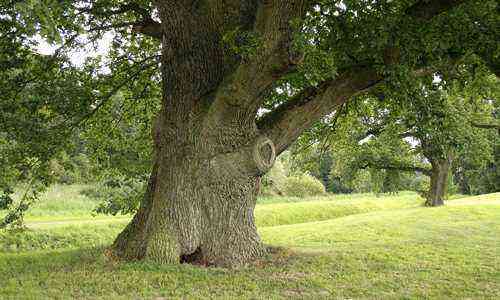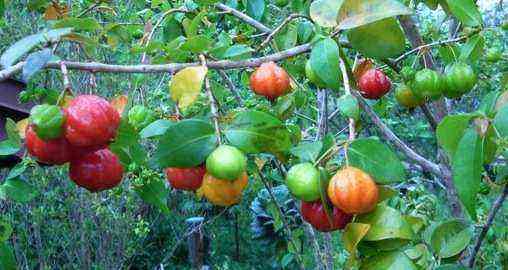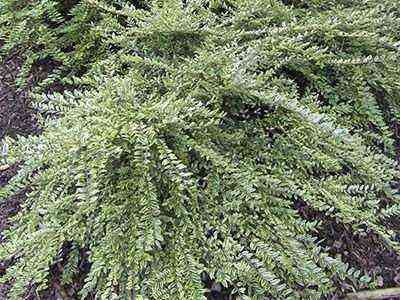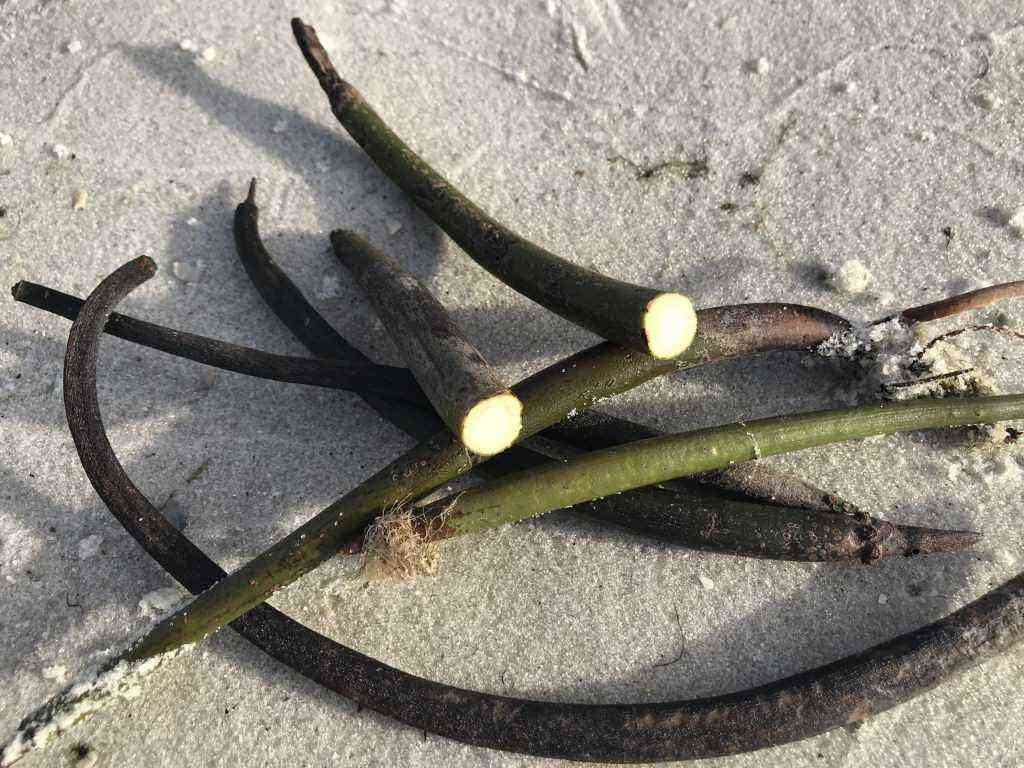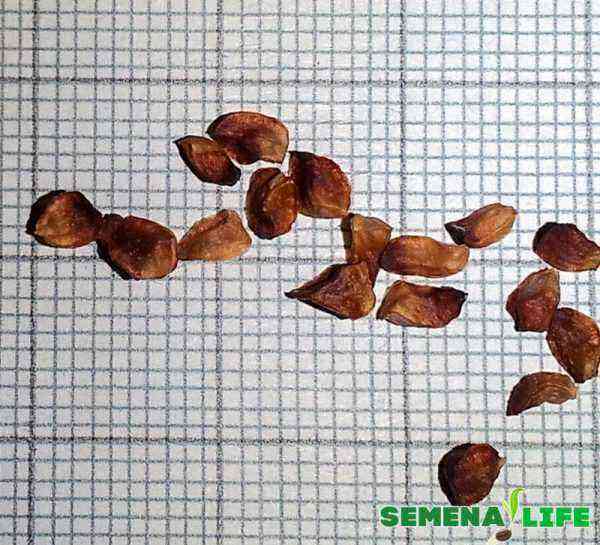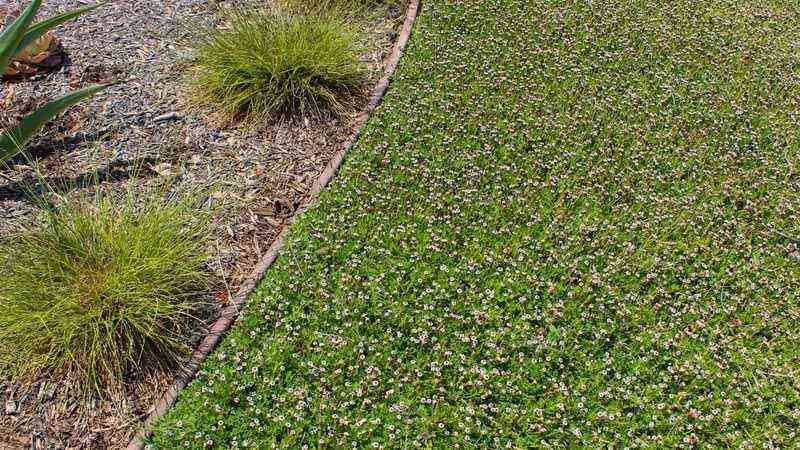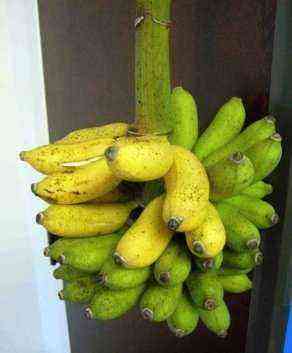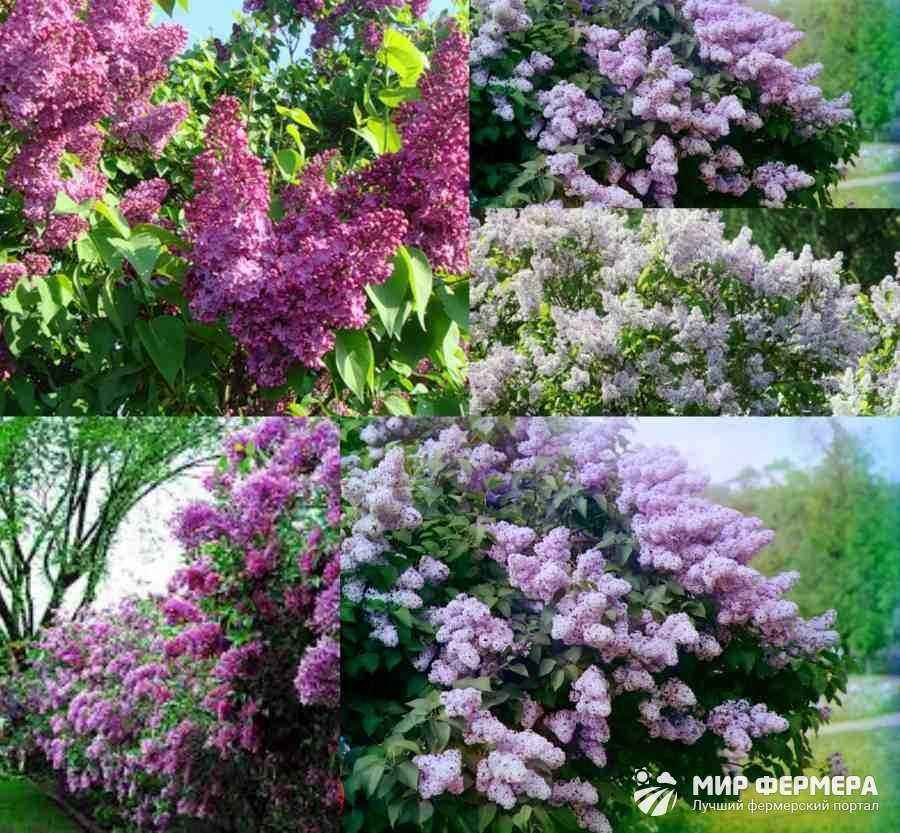It not only replenishes the substances spent by the soil on the development of plants, but also improves the structure of the soil.
However, improper use of this material can not only reduce yields or make the fruits of plants unsuitable for consumption, but also render the soil sterile for many years.
In this article, read:
- what does cow dung contain and why is it used in the garden;
- how to cook humus from it;
- how to prepare and dilute liquid mullein for watering and feeding plants;
- is it possible to use fresh manure in spring, and in what form is manure used as fertilizer at different times of the year;
- how much is cattle manure, its pros and cons.
How and why is it used in the garden?
Cattle, like other living things, are participants in the global metabolic process, in which the same substance is always not only the waste of some, but also the food of others.
Mullein contains substances that are food for humic (soil) microorganisms, which, in turn, secrete humic acids, that is, the very substance that is food for plant roots.
In addition, cow excrement contains many different micronutrients that are necessary for both soil-dwelling insects or worms and plants.
How is organic soil fertilization useful?
The use of animal waste products is useful not only for plants. Thanks to plant residues and other chemical substances in excrement, microflora actively multiplies in the soil.
Soil microorganisms participate in the mineralization process, which begins from the second month after fertilization. First, the number of ammonifying bacteria, actinomycetes, increases. Then their number decreases, but the population of phosphobacteria increases.
For example:
- in semi-decomposed manure of ammonifying bacteria contains more than 2 million in 1 gram, after 2 – 3 years their number decreases by a third;
- phosphobacteria in the fresh substance is a little more than 2 million, in the semi-rotted 58 million, in the rotten – 157 million in 1 gram.
When fertilizer enters the soil, the number of bacteria increases from 3 to 20 times, which prevents the loss of nutrients, as soil microorganisms begin to process them and transform them into a form that is faster and better absorbed by plants.
Video: When and what kind of manure can be brought into the garden
The process of microflora activation occurs faster if nitrogen and phosphorus fertilizers are introduced into the soil simultaneously with manure.
The presence of humus in the soil is the main condition for the harvest. The introduction of manure into the soil in autumn increases the amount of humus – organic matter, a decomposition product of plant and animal residues and microorganisms. The humus contains humic and humic acids, humin.
The substance is black, so it is believed that the blacker the soil, the higher the yield. The highest content of the substance is in the chernozem soil. Microorganisms and fungi process organic matter into simpler compounds. For example, earthworm excrement is humus.
But in order for the soil to be loose, a large amount of organic matter must enter the soil – ash, green manure, cattle waste, so that microorganisms have a source of nutrition.
The number of soil bacteria can be maintained with special EO preparations, but when using only mineral fertilizers, a constant amount of microflora cannot be achieved, since there is no plant nutrition for it.
Important! To maintain the activity of soil bacteria and earthworms, it is necessary to add plant or animal organic matter to the soil every two years – mullein, plant residues, ash, bone waste
What is a mullein?
A mullein is called both the excrement remaining after the cows in the form of cakes, and the fermented or beginning to decay aqueous solution of cattle manure. There is no clear reference of the name to manure or fertilizers from it, therefore sometimes confusion arises, even within the same settlement.
That’s why we we propose to assign this name to the material in the form of an aqueous solution fresh or partially rotted cow dung.
Nevertheless, it cannot be said that any of the applications of the term “mullein” is incorrect, because it is a popular, that is, an unofficial name that is not spelled out in any document.
Why do you need humus
Correct use of humus fertilizer provides plants with a full range of nutrients. In addition, humus has a positive effect on the structure and fertility of the soil. So when using humus for the main autumn cultivation, the porosity of the soil increases, which has a positive effect on the flow of water and air to the root system of plants.
Also, small particles of humus contain fulvic acids and humic acids, which contribute to the conversion of minerals into forms accessible to plants.

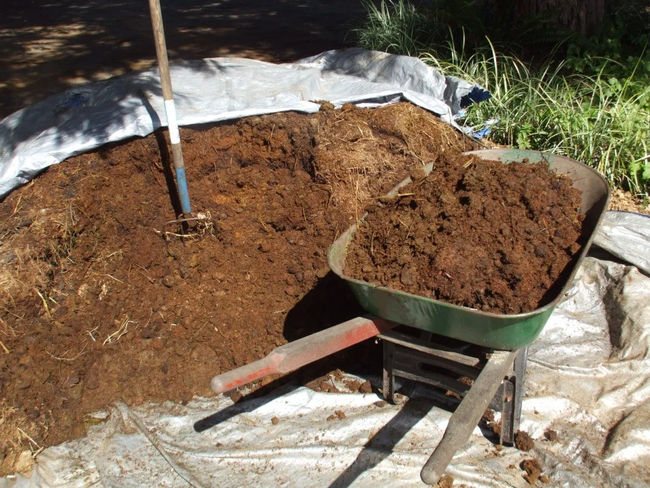
A fairly effective and justified way of using humus is mulching, which has a positive effect on the reproduction of beneficial microorganisms and prevents excessive evaporation of moisture from the soil surface. Such fertilizer from humus can reliably protect plant roots from night frosts.
Chemical composition
Most of the fresh manure (70–99%) is water. This variation depends on both the conditions of detention and the method of cleaning. Where the barns are equipped with urine drainage and scraper manure systems, the moisture content of excrement is minimal at 70–80%. If the flushing method is used to clean the barn, then the proportion of water is 85–99%.

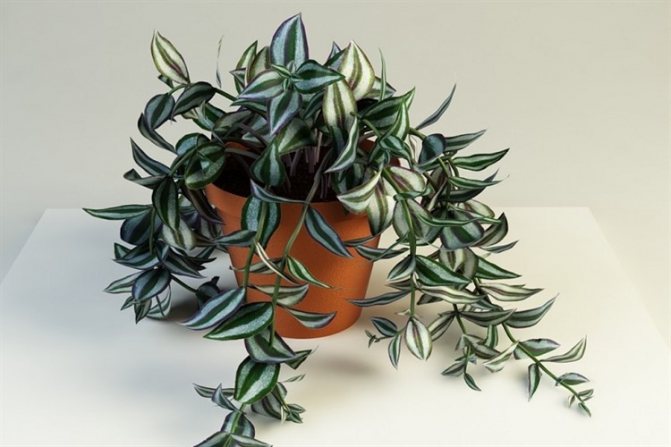
Beyond water chemical composition of excrement includes:
- Nitrogen and its compounds (0,5–2%), and its proportion depends on nutrition and urine drainage. If the barn is not equipped with a urine drainage system, the proportion of nitrogen in the feces will increase. Also, the amount of nitrogen is increased by pelleted feed.
- Potassium in the form of K2O oxide (0,5-0,7%), this indicator depends on the diet of the animal – its amount is increased by some pelleted feed and food additives.
- Calcium in the form of CaO oxide (0,25-0,5%), its amount depends on the presence and amount of bone meal and other calcium-containing foods in the animal’s diet. In addition, an increase in the amount of calcium in manure may indicate serious metabolic problems in cattle.
- Phosphorus in the form of oxide P2O5 (0,25-0,5%). Its amount depends on the proportion of pelleted feed – the more there are, the higher the phosphorus level.
In the volume of hundredths and thousandths of a percent in cow dung there is almost the entire periodic table.
Sometimes, even salts of heavy metals are found in cattle excrement, but their amount does not exceed the same parameter in the surrounding grass.
What is the difference between the types of manure?
Manure differs in composition and decomposition rate, depending on which animal it comes from. Therefore, the use of different types has its own characteristics.
Measly
It is a moist, soft, sometimes semi-liquid, dense substrate. Rotting occurs at a temperature of 15-25 degrees. Decomposition rate is average.
Toadstools often breed in it, so it is recommended to add a little lime when applied to the ground. Good moisture retention. Suitable for sandy loam and clay soils. The effect of fertilization from cow dung lasts up to 2-3 years. Application rate 7-10 kg per 1 sq. M.
To improve the structure, sawdust is added to it and, after rotting, is introduced into the soil in the fall. Also, a liquid mullein is prepared from it – this fertilizer, with sufficient dilution with water, is used even in summer.
Horse
Its structure is loose and porous. Decomposes at a temperature of 50-70 degrees, in this regard, the process is faster. It is used for fertilizing heavy soils. Makes it more airy and light. Has a varied chemical composition. Due to the release of a large amount of heat, it is often used in greenhouses and greenhouses.
The consumption rate is 3-5 kg per 1 sq. M. It is more difficult to get it, since the horses are bred less. Before laying for decay, excrement is mixed with sawdust. Lime is added when making.
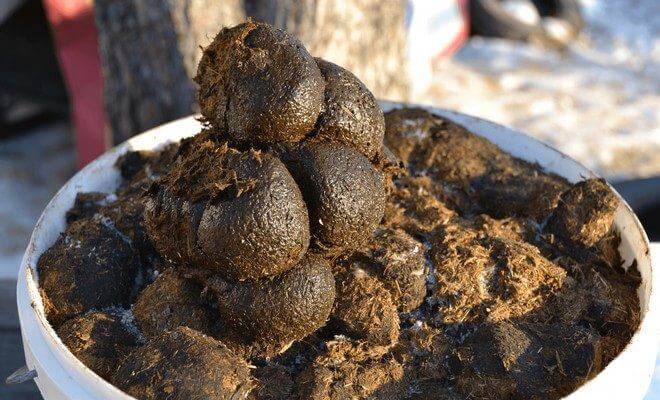
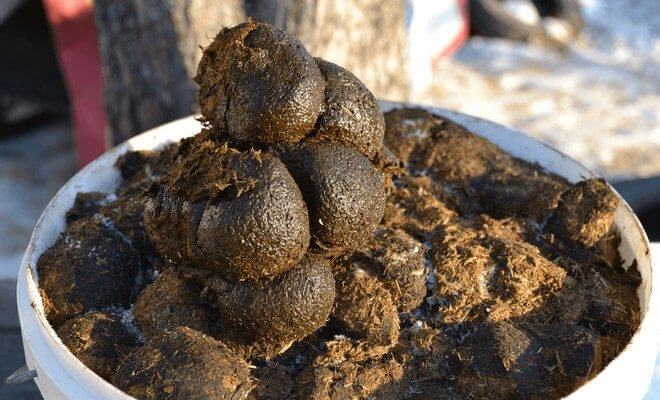
Pork
It has a semi-liquid structure. Differs in high acidity, therefore, it is necessary to add lime when adding. It decomposes for a long time, at a low temperature. To speed up the process, it is mixed with horse. Contains a large amount of weed seeds. Suitable for light soil types. Brought in at the rate of 4-6 kg per 1 sq. M.
Sheep
Contains a lot of nitrogen and potassium. The structure is dense, hard and dry. Decomposes at high temperatures – 70 degrees, but very slowly. To speed up the process, sheep excrement is mixed with slurry. Used on clay soils.
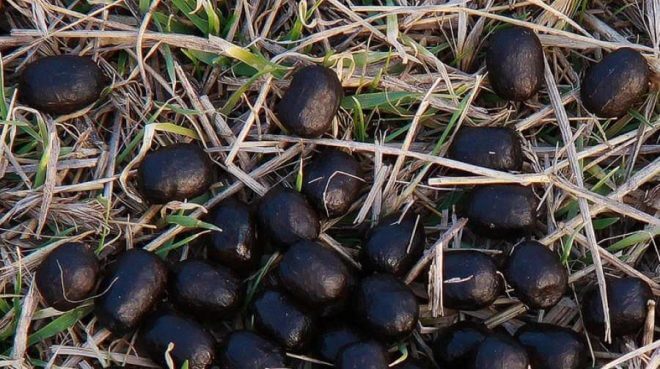
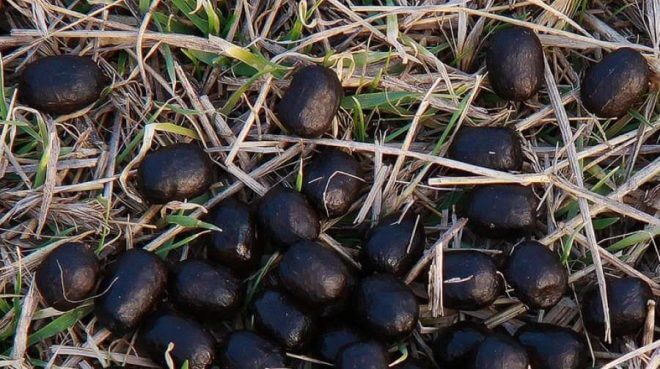
Rabbit
Solid and dense in structure. Suitable for clay and depleted soils. Loosens the earth. In terms of nutrients, it is not inferior to cow and horse. Decomposes slowly. Does not contain weed seeds.
Chicken droppings (bird droppings)
The record holder for the content of nitrogen, phosphorus and potassium. These substances are so concentrated in it that use is possible only after diluting with water 10-12 times. For autumn digging, they are introduced dry, 1-3 kg per sq. M. The structure is soft and moist. Decomposes quickly.
Dog droppings
Dog excrement is rarely used as fertilizer. This is because dogs are not herbivores, so their droppings are of little value. It contains phosphorus and calcium, but helminths can also be present with them. Therefore, there are more arguments against dog dung for fertilization than for. If used, then only after prolonged decay in the compost heap.
Strawberries at home all year round! These veneers are 100 times better than a false jaw! And there are pennies! Up to 15 kg of strawberries every month! False dental veneers for a penny! Up to 15 kg of strawberries every month! Famous overhead veneers are now in Russia!
How to use it?
The correct use of this material not only accelerates the development of plants and increases yields, but also often helps to cope with diseases caused by a lack of certain substances.
However, improper use will not only severely harm the plants and poison the crop, but it can also render the soil sterile, preventing even weeds from growing on it.
Fresh
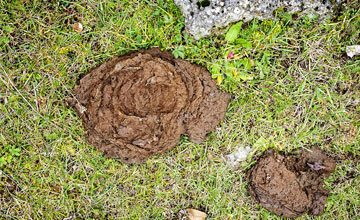

Fresh excrement is very toxic to soil and plants, therefore before using them, it is imperative to soak them on pus for several days, that is, a plot of land specially designated for these purposes.
During this time, part of the moisture will be absorbed into the ground or evaporate, thereby reducing the toxic effect of fresh manure on the soil and plants.
After that, the dried material can be:
- apply to areas left under steam;
- fertilize individual plants by spreading manure around at a distance of 20-50 cm from the trunk;
- use for underground heating of soil in greenhouses or garden beds;
- used for the manufacture of liquid fertilizers.
Application to areas left under steam
This way of using mullein restores all the nutrients used by the soil for plant development, and also improves the structure of the soil. During the winter, the introduced material does not have time to rot due to the low temperature of the soiltherefore, its toxic effect kills weed seeds in the spring.
From spring to autumn, the material gradually decays and by the next spring turns into high-quality humus, which is evenly distributed over the entire upper layer of the soil after spring plowing.
It is possible to distribute the mullein over the site either manually, bringing it in a wheelbarrow, or with the help of attached tractor equipment adapted to work with such aggressive material. The thickness of the layer depends on the method of plowing or digging and should not exceed 30% of the penetration depth of the plow or shovel.
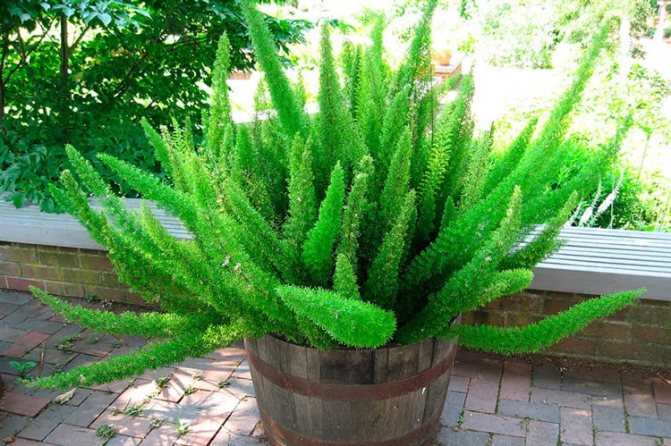
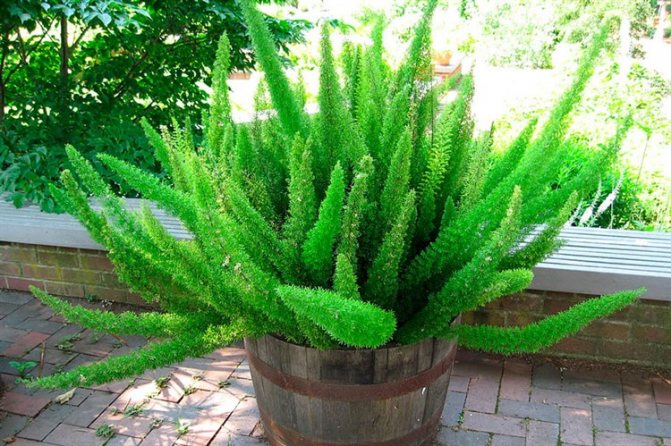
After plowing or digging manure evenly distributed in the upper soil layer, thanks to which the bacteria that woke up in the spring will process not only it, but also rotted plant remains and other organic matter.
In late spring or early summer, the site must be treated with an aqueous solution of bacterial preparations, this will increase the number of bacteria and allow them to quickly process all organic matter into humus.
You can do without digging and processing with bacterial preparations, in this case you will get the usual mulching with manure.
For individual plants
So that cattle excrement does not harm the plants, it is necessary to reduce their humidity (the optimal level is 75–85%) so that liquid from them could not penetrate deep into the soil.
The first watering after applying such fertilizer should be carried out in 3-5 weeks, during which time the manure will dry out even more, and some of the substances toxic to plants will decompose or will be processed by bacteria.
If for some reason it is impossible to postpone watering for such a period, then it is necessary to use partially rotted excrement, which has lain on the pus for at least a month, and before that had been treated with bacterial preparations.
Underground soil heating
The bacteria digesting excreta release heat energy that can be used for underground heating of the soil.
To do this, under a garden bed or greenhouse:
- dig a deep trench;
- insulate the walls of the trench with dried manure;
- fill the trench with fresh manure;
- start the decay process;
- a fertile layer of earth is poured on top;
- planting seeds or seedlings.
In more detail, all the stages of such a use of manure are described in the article on greenhouses.
Making liquid feed
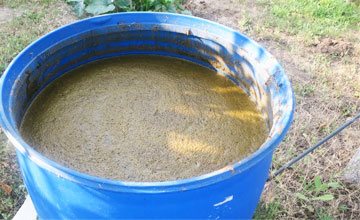
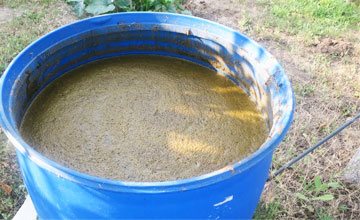
Liquid fertilizer made from fresh cow dung is called differently, some talker or bumpy, some mullein or infusion.
A properly prepared fertilizer is suitable not only for watering the soil, but also for spraying foliage, and the latter helps to cope with many diseases caused by a lack of various micronutrients.
To prepare fertilizer, fresh excrement of any moisture content is mixed with water, and one part of the manure accounts for 10 or more parts of water. The concentration of the solution is determined based on its purpose, that is, for:
- general fertilization of the soil left under fallow area – 1:10;
- application under the roots of plants or general watering of the planted area 1:70;
- watering the site before planting seedlings – 1: 150;
- spraying leaves and watering the site before planting seeds – 1: 200.
The bump is prepared like this: fresh the excrement is placed in a large container and filled with fresh water in a ratio of 1:10, that is, one part of manure accounts for 10 parts of water. Then the contents of the container are stirred and left for 10-15 days, stirring once a day.
A sign of the readiness of the mixture is a change in smell – instead of the characteristic “aroma” of cow dung, a swampy smell will appear.
The finished mixture is either poured on the ground (the concentration depends on the degree of depletion of the soil and can be 1-50 liters per 1 m2), or diluted to the required strength. You can use a regular plastic garden watering can for watering, and a telescopic garden sprayer can be used to spray the leaves.
But before refueling the sprayer, the mixture must be drained with the help of several layers of gauze, otherwise any large particle of manure will clog the device, and it will have to be completely disassembled for cleaning.
Partially rotted
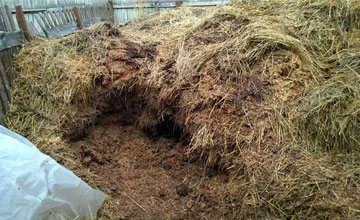
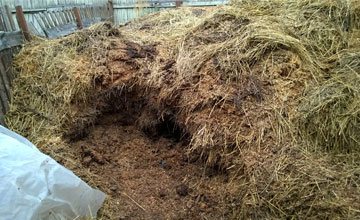
Partially rotted cow excrement contains noticeably less substances toxic to plants than fresh manure, and due to the short period of decomposition, the bacteria have not yet had time to turn it into humus.
When applied to warm soil and sufficient moisture (minimum 75%) bacteria in 1-2 weeks will turn most toxic substances into harmless, and also have time to turn some part into humic acids, that is, the natural nutrition of plant roots.
Therefore, partially rotted material is used for:
- winter mulching;
- fertilizing individual plants;
- making dressings.
Winter mulching
Winter mulching with partially rotted cow dung is performed several weeks before the onset of frost. Due to the low air temperature, bacteria hibernate, and repeated temperature transitions through the zero mark will effectively loosen the mulching material.
With the arrival of heat, the activity of bacteria will resume, due to which, by the time of planting, most of the toxic substances will be destroyed, however the release of humic acids will continue throughout the year… So, after each watering, the plants will receive additional nutrition.
The thickness of the mulch layer depends on the further use of the site, if next year it is planned to be planted, then the thickness of the mulch layer should be 1–3 cm. If the next year it remains under steam, then the layer thickness should be 5–10 cm.

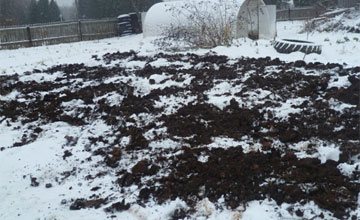
If the site is without planting, then it is covered with a continuous layer of mulch.
If there are some plants on it, then you need to lay mulch so that there is free space around the trunks with a diameter of 15-30 cm.
The free space around the trunk can be left without mulching or covered with humus, earth or healthy fallen leaves.
For individual plants
If it is necessary to fertilize not the entire vegetable garden or garden, but only individual plants, then a ring of partially rotted manure 15-30 cm wide is laid around the trunk at a distance of 10-30 cm.
For some cultures, such as:
- roses and fruit trees;
- cabbage;
- eggplant, zucchini;
- tomatoes and cucumbers;
- pumpkin;
- spinach,
you can only retreat 5 cm, however, the space between the trunk and the manure must be covered with a thick layer of ash. This will protect the plant from burns and reduce the acidic effect of rotting organic matter on the soil.
Making dressings
Top dressing from partially rotted manure is less toxic than fresh manure, and they are made in the same way as from fresh excrement.
The only difference is that after infusion for two weeks, the manure completely decays, and for any application, a concentration of 1:10 is permissible.
The exception is top dressing. for spraying foliage – it is bred to the most convenient state, adjusting to the available sprayer and thoroughly filter through several layers of gauze before pouring into the apparatus.
Humus
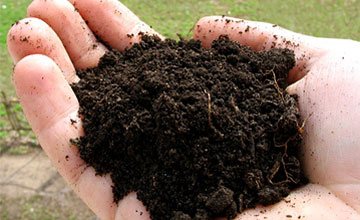
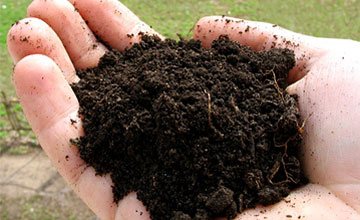
The basis of humus is humic acids, which are ideal for nourishing plant roots, therefore completely rotted excrement is used as mulch and universal fertilizer.
Mulching can be performed at any time of the year, and the thickness is chosen based on the ease of use and the requirements for the mulching layer.
In most cases the thickness of the mulch is 5–20 cm, and the main factors limiting its thickness are the height of the lower branches and the availability of humus.
The only difference between fertilizing the land and mulching is that after fertilization, the plot is plowed or dug up to mix the soil with humus, and the mulch is mixed with the soil gradually, thanks to the movement of water and the activity of various underground living creatures.
If it is necessary to fertilize a separate plant, then the humus is poured in a circle, dense to the trunk, and the amount of fertilizer is determined individually.
How much material is needed depends on:
- plant conditions;
- soil condition;
- the availability of humus.
The following ratios can be used:
- tomatoes, cucumbers, cabbage, etc. – 5–7 liters per plant;
- large bushes and young trees – 10-15 liters;
- mature fruit trees – 1-3 buckets.
Dry or granular
Dry excrement of cattle, including in granular form, also effective for:
- making liquid top dressing;
- heating greenhouses or beds;
- making humus;
- fertilization of fields left under fallow.
Making liquid feed
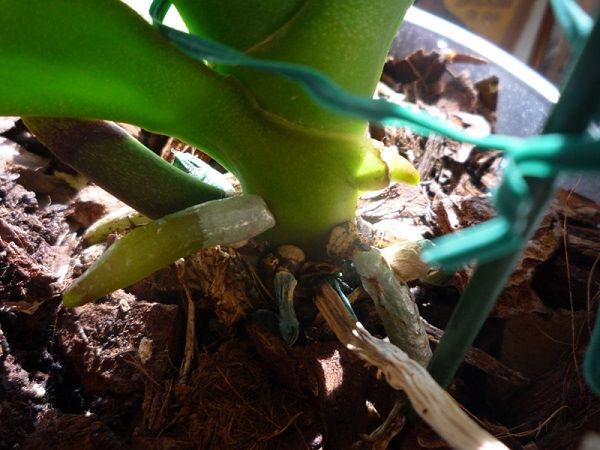
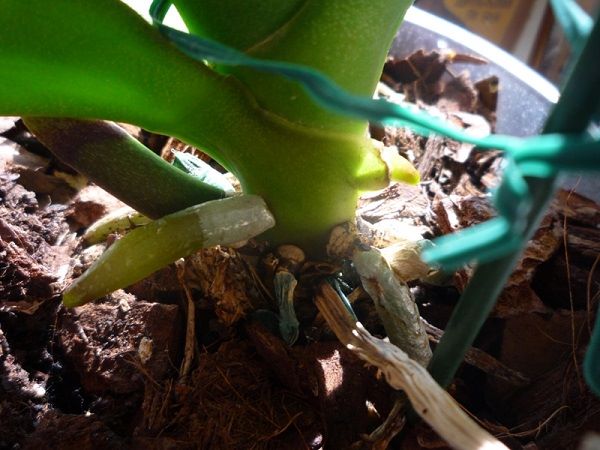
For the manufacture of liquid top dressing, dried or granular manure is placed in a container and poured with water in a ratio of 1:10.
That is 1 kg of dried excrement accounts for 10 liters of water, and then add a bacterial preparation for composting manure.
On the first day, the contents of the container are stirred at intervals of 1–2 hours so that the dry excrement becomes acidic and dissolves as much as possible in water.
It is advisable to dissolve dried manure on a warm sunny day, using water heated to a temperature of 35–45 degrees, this will not only speed up the soaking of excrement, but also create the most favorable conditions for bacteria to work.
If it was possible to start the decomposition process, then the mixture will begin to bubble, if there are no bubbles, it is advisable to reheat it to a temperature of 35-45 degrees… Once the process has started, the mixture can be used in the same way as a mullein made from fresh excrement.
To get a partially rotted top dressing, you need to wait for the smell to change, that is, instead of the characteristic manure, wait for the marsh one.
After that, the mixture is used in the same way as a bump from partially rotted manure. Typically, this decay takes 10-30 days. After 2-4 months the mixture can be used for sub-root and general application at a much higher concentration (usually 1:20 or 1:30).
Heating of greenhouses and beds
The main difference from fresh manure is that in a trench dug and insulated with dry excrement fall asleep granules or crushed dry feces and poured with hot (70-80 degrees) water in a 1: 1 ratio.
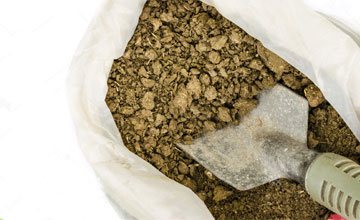

After a minute, the decaying mixture is poured with a bacterial preparation warmed up to a temperature of 40 degrees.
The next day, the mixture is checked, if it is hot inside, then the decay process has begun, and you can fill in the soil, followed by planting seeds / seedlings.
If not, it is necessary to heat the mixture in several places to a temperature of 40–45 degrees in order to activate the bacteria.
Fertilizing fallow fields
For fertilizing fields left under steam, dry, including granular excrement scattered over their surface and plowed or dug up… Therefore, the layer thickness should not exceed half the plowing or digging depth. Then the area is watered with water.
If the site is fertilized in summer or early autumn, when daytime temperatures exceed 20 degrees, then after watering it is treated with bacterial composting preparations.
In the spring, the area is watered again and again treated with composting preparations. The third watering is carried out in the middle of next autumn, after mowing natural vegetation and plowing / digging, while bacterial preparations are no longer introduced.
Making humus
This operation can be performed in:
- metal, plastic or wooden container;
- a hole dug in the ground;
- flat earthen area (pus).
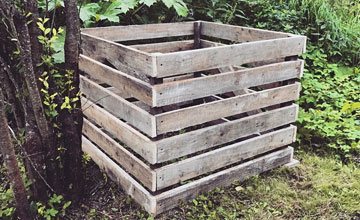
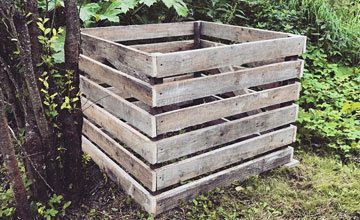
The box is suitable in those cases when you need to get a little (1–5 m3) of the finished product, as well as in those cases when it is impossible to select a section of the field for decay and you have to do this work on concrete, tiles or asphalt.
A pit in the ground is well suited for rapid decay in cold regions or for quick humus production in winter in warm regions.
Pus is used in cases where there are no restrictions on the volume of the finished material and the time of work.
To start the decomposition reaction, 2–3 mass parts of dry excrement are mixed with one part of water at a temperature of 70–90 degrees and, after mixing, are treated with bacterial composting preparations for manure.
If the process of rapid decay was not started the first time, then stones heated to a temperature of 80-90 degrees are dipped into the loosened mixture.
For pus, excrement is also mixed with hot water, but they are treated with bacterial preparations only if it is necessary to accelerate decay.
Humus or manure: which is better?
Manure differs in the degree of decay. During this process, the amount of nitrogen in the mass decreases, and it gradually stops “burning”. A completely rotted composition is safer for plants than a fresh one. But fertilizer is used in a different state, since the decay process can last for several months or years.
Types of manure according to the degree of decay:
- Fresh. Dense mass with an admixture of litter or in its pure form. For feeding, it is used mainly in the autumn period, when the crop is harvested. When applied during the growing season, it is diluted in water 10 times.
- Semi-ripe. A drier mixture, from manure that has lain for 3-6 months. The composition is partially decomposed, but straw and mass heterogeneity are visible. It is used in the fall before digging up the site.
- Humus. Homogeneous mass. Easily crumbles. The nitrogen content in it is several times lower than in fresh. Suitable for application during the growing season and before planting.
To preserve nutrients during decay, manure is stored in a variety of ways. In the open air, without tamping, the process goes very quickly, the mass heats up very much and loses up to 40% of the elements.
Compaction of layers allows you to lower the temperature to 30 degrees and slow down decay. In this case, most of the nutrients are retained, but a product ready for use can be obtained only after 8-10 months.
To speed up decomposition, growers use a mixed storage method. First, the mass is stacked freely, and after it starts to “burn” it is strongly tamped. To create a greenhouse effect, it is covered with a layer of peat or grass, and then with a film.
How to dilute cattle excrement in order to prepare liquid top dressing from them?
To make top dressing, cattle excrement is placed in a metal or plastic container of a suitable volume, then filled with fresh water in a ratio of 1:10 (1 kg of manure accounts for 10 liters of water).
Then the contents of the container are thoroughly mixed and left for 10-30 daysso that bacteria have time to partially process organic matter and reduce its toxicity to plants. A sign of the readiness of such a fertilizer will be a change in smell – instead of manure, it will begin to smell like a swamp.
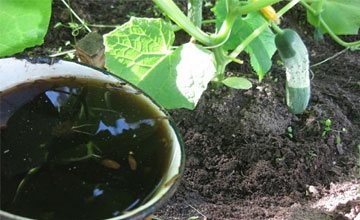
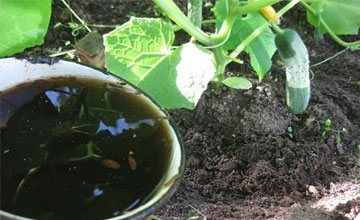
After that, liquid top dressing is either used to irrigate the area left under steam, or diluted even more for various methods of further use, such as:
- watering under the roots – 1: 7;
- watering the site before planting seedlings – from 1:15 to 1:20;
- spraying foliage and watering before planting seeds – 1:20.
Liquid and granular manure
To make the use of manure possible in urban conditions, far from farms, fertilizer producers produce products based on it – these are “liquid manure” and “granular”.
These types of fertilizers are convenient to use, do not have a pungent odor and are easier to calculate the application rate.
Granules – dry compressed manure, cleaned of impurities, pathogenic microorganisms and weed seeds. 1 kg of pellets is 4 kg of manure. Moisture is required for activation, therefore, after application, the area is watered abundantly. The granules dissolve slowly – the effect lasts for the entire growing season. Average consumption 10-15 kg per 100 sq. Introduced in the spring, mixing with the topsoil.
Liquid manure in plastic bottles is a concentrate. 1 liter replaces 100 kg of fresh manure. The liquid is used for irrigation. It can be used during the growing season. Since the substances are already dissolved, the period of action of this agent is shorter than that of granules.
Strawberries at home all year round! These veneers are 100 times better than a false jaw! And there are pennies! Up to 15 kg of strawberries every month! False dental veneers for a penny! Up to 15 kg of strawberries every month! Famous overhead veneers are now in Russia!
What crops is mullein suitable for, and what can you water with it?
Fresh manure in an undiluted state is a threat to any plant, because it contains many toxic substances.
But highly diluted mullein you can water such cropsAs:
- roses and most garden bushes;
- potatoes;
- beans;
- peas;
- cucumbers;
- zucchini;
- eggplants;
- cabbage;
- fruit trees.
For these plants benefits not only a highly divorced chatterbox, but and making a small amount in the fall partially rotted or fresh cow dung.
Moreover, the fresh one must be applied 2-3 times less than the partially rotted one, otherwise you can harm the plants. In addition, even these plants on fertile soil should not be fertilized with fresh or partially rotted manure, otherwise there will be too many nitrogenous compounds in the fruits.
Pig Manure Applications
Pig manure, less often than cow and horse manure, is used to fertilize crops. To maximize the benefits of manure, it is important to know when to apply the manure.
The term for fertilizing the soil depends on the degree of decomposition of the pork manure:
- Fresh manure (shelf life no more than 3 months) is not used to feed the soil. It contains too many aggressive components that can destroy agricultural crops. The only time when fresh pork droppings can be introduced into the soil is in the autumn season, and in the option if animal feces are mixed with horse manure.
- Semi-overripe (shelf life from 3 months to six months) droppings can be applied to the soil at the end of autumn, always after collecting the entire crop and plant residues in the ridges. The consumption rate of semi-rotted manure is per sq. m. of the site is used up to 3 kg of organic matter.
- Overripe (shelf life from six months to a year) litter is also introduced only in late autumn during plowing of the site. Consumption rates – per sq. m. of soil is used up to 7 kg of organic matter.
- Humus is allowed to be used at any time of the year. Manure is applied directly to the soil during plowing of the area.
It is forbidden to exceed the recommended ratios of organic fertilizers, as this can be hazardous to the health of agricultural crops.
In terms of its beneficial qualities, the humus of pigs is compared with the droppings of cows or horses. To improve crop yields, it is recommended to mix pig manure with other types of farm animal droppings.
If you add humus in the fall, then next year in the spring it is good to plant carrots, cabbage, zucchini, pumpkin, onions on the garden bed. Fresh and semi-rotten manure is used to fertilize the ridges on which it is planned to grow potatoes, eggplants, blackberries, peppers and some flowers (dahlias, mallow, cloves). The overripe type of litter is well placed on the ridges, where tomatoes, garlic, corn, beets will grow and bear fruit.
How to apply at different times of the year?
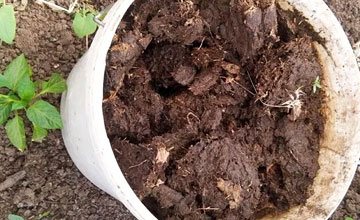
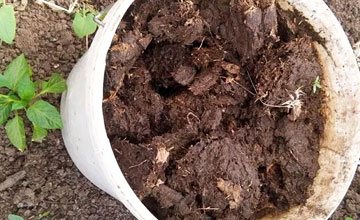
Animals eat and therefore defecate daily, which is why manure appears not only when it can be applied to the fields, but also at other times.
Therefore, cattle owners have to look for ways to dispose of the waste of their animals, because throwing out excrement is not allowed, because it is illegal (read more here) and economically unjustified.
After all, manure is potentially an excellent fertilizer, as well as a material for the manufacture of many useful products, which we talked about in this article. Therefore, further we will talk about how to use cattle excrement at different times of the year, and what can be made of them.
In the spring
In most cases, it is impossible to bring fresh cattle excrement into the ground in the spring, because they do not have time to rot not only before planting seeds or seedlings, but even before ripening the fruits, therefore, instead of being useful, such fertilizer will only harm.
Therefore, it is best to transfer all the collected manure to humus in the spring, transporting it to pus, and also loading it into containers or pits prepared for this.
Due to low temperatures in spring, the rate of decay on pus is noticeably lower than in a pit or container, because, unlike them, the pit cannot be insulated. However, the rate of decay can be increased by using bacterial preparations.
The exception is greenhouses, hotbeds and beds, which need to be warmed up for earlier planting of seeds or seedlings. For this remove the fertile soil layer and dig a trench of sufficient size.
This trench is insulated and filled with manure, in which the process of “combustion”, that is, decay, is started. By next spring, all the manure laid in the trenches will turn into good humus, which can be used as fertilizer for any plants.
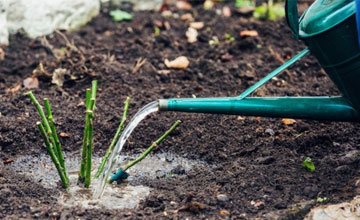
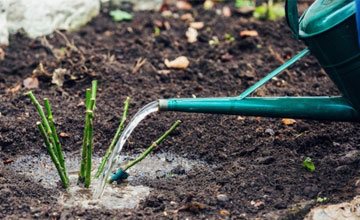
In addition, it is in the spring that the use of dressings from fresh or partially rotted manure is most effective.
After all, then the plants are actively developing, so the soil cannot always provide them with a sufficient amount of nutrients and trace elements.
And feeding with mullein in spring allows you to cope with the lack of these substances, thanks to which the plants not only develop faster, but also get sick less.
In addition, liquid top dressing contains few substances hazardous to plants, which means that they cannot spoil the crop by filling it with toxic nitrogenous compounds.
Lettom
Most garden and horticultural crops yield in summer, therefore, before harvesting, they cannot be fertilized with fresh or even partially rotted cow dung, this is will lead to the accumulation of nitrates in the fruit and make them not only unusable, but also dangerous.
It is pointless to apply fertilizer from excrement immediately after harvesting the fruits, because this will lead to useless growth of green mass, which makes the tree less prepared for winter and can get sick during frosts.
If the plants bear fruit in late autumn, then at the beginning of summer this land can be fertilized with liquid dressings from both fresh and partially rotted manure. Flowers and other plants that only bloom in autumn can be fertilized all summer long with liquid feed from cattle excrement.
Therefore, in the summer it is also necessary all collected but unused excrement should be removed to the pus or put in boxes / pits for decay.
In the autumn


After the foliage has fallen off, the soil on which the plants “loving” manure will be planted next year can be fertilized with fresh excrement with obligatory treatment with bacterial preparations.
In addition, it is advisable to take cattle waste to the fields left for next year under fallow.
For such a period, manure completely decay even without treatment with bacterial preparations, therefore, by the time of the new planting, the earth will be maximally saturated with nutrients, and its ability to transmit and absorb moisture is increased. The remains of manure, which have not been used in the fields, must be taken out on pus or loaded into pits / boxes for decay.
in winter
In winter, only those areas that will be left fallow for the next year can be fertilized with cattle excrement, so the bulk of the manure has to be turned into humus.
If you use insulated pits or boxes for this, and also treat excrement with bacterial preparations, then by the middle of spring you will get high-quality humus, which can be used to fertilize any plants.
Even without the use of bacterial preparations, insulated pits / boxes by mid-spring will produce partially rotted manure, suitable for making liquid dressings.
Manure as fertilizer
Manure is the excrement of herbivores with an admixture of litter or in pure form, with varying degrees of decay. The composition depends on the diet of the livestock and the type of bedding. Straw, sawdust, grass can be used as the latter.
The manure contains colonies of microorganisms that promote the growth of soil microflora and participate in the formation of humus. It increases the natural fertility of the earth, makes its structure loose and permeable to moisture and air.
The biomass contains all the substances necessary for plants. Their ratio and combinations differ depending on which animal it is obtained from.
Strawberries at home all year round! These veneers are 100 times better than a false jaw! And there are pennies! Up to 15 kg of strawberries every month! False dental veneers for a penny! Up to 15 kg of strawberries every month! Famous overhead veneers are now in Russia!
The composition of manure is alkaline, so it reduces the acidity of the soil. The average pH of manure is 8-9 units.
Table 1. NPK content in manure
| Manure type | Nitrogen g / kg | Phosphorus g / kg | Potassium g / kg |
| Pork | 8,1 | 7,9 | 4,5 |
| Rabbit | 6,0 | 6,0 | 4 |
| Avian | 16,0 | 13,0 | 8 |
| Sheep | 8,0 | 2,3 | 6,6 |
| Measly | 3,5 | 3,0 | 1,4 |
| Horse | 4,7 | 3,8 | 2,0 |
Manure is the best organic fertilizer. Its composition is multicomponent and natural for the ecosystem. Plants easily get nutrients and trace elements from it.
Biomass improves soil fertility and quality for a long time. The effect of a single application lasts for 2-3 years due to prolonged decomposition and gradual release of substances. And on clay soils, where this process is slowed down, up to 6-7 years.
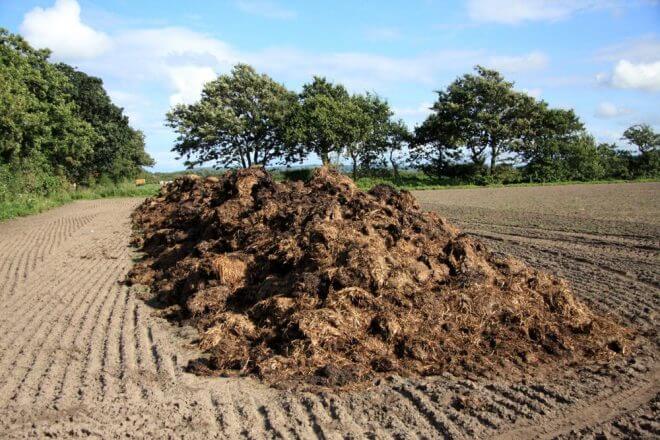
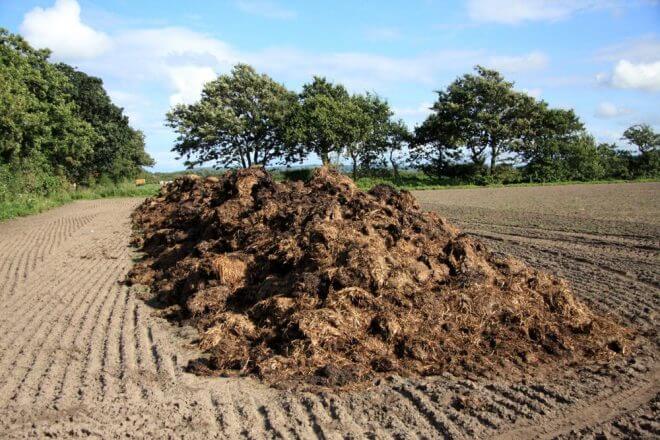
Where to get it, and how much does it cost?
Residents of rural areas can collect manure from local farmers who keep small herds or individual animals. but the main suppliers of excrement are livestock farms, on which tens of thousands of animals are raised.
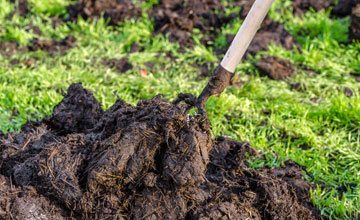
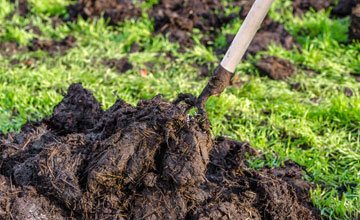
The official purchase of waste cattle livelihoods is hampered by the need to obtain a license to handle hazardous waste.
Therefore, not all farms are associated with the official sale or even free distribution of this material.
Nevertheless, there is always the possibility of reaching an informal agreement, as farms are interested in getting rid of the accumulated waste.
In addition, you can find intermediaries offering both manure and humus from it.
The cost of cattle excrement depends on:
- there is an excess of this material among livestock breeders, the more it is, the cheaper they will give it away;
- batch size (the less, the more expensive);
- the state of the material (fresh, humus, granular, etc.);
- the number of intermediaries (the more there are, the more expensive, therefore it is cheaper directly from livestock breeders);
- packing (prepackaged material is always more expensive than bulk material);
- the distance from the storage site to the place of application (the farther, the higher transport costs, and hence the higher the unit price).
In addition, the price of cow dung will depend on the demand for this material in the region or village – the higher the demand, the more expensive.
therefore There is no some clear price for fresh cow dung, because in one place they will gladly give it away for nothing, and in another they will ask for 100 or more rubles for a bag.
When is the best time to apply to the soil?
Depending on the season and climatic characteristics of the region, different types of manure are introduced into the soil in terms of the degree of rotting and they are embedded at different depths. If these rules are neglected, then the opposite effect can be obtained from fertilization and the yield will decrease.
Advice! In arid regions, top dressing is applied deeper (20-30 cm) than in those where there is enough precipitation (10-12 cm).
Spring
Fresh manure is not applied in the spring. The biomass is used only on poor soils that were not fertilized in the fall. It is possible to use semi-rotten manure and humus for late crops when planting.
Sometimes the composition is scattered over the snow, while it is necessary to increase the rate by 1,5 times, since some of the substances will disappear before the fertilizer reaches the ground.
Summer
During the growing season, the use of fresh manure and humus is not recommended, since fertilization will not give an effect in a short time, and it can harm the root system and the general health of the culture.
In summer, only weakly concentrated solutions of liquid manure are used for feeding with nitrogen, potassium and phosphorus. It is bred 5-6 times and the plants are watered during the formation of the first leaves. Consumption 10 liters per 1 sq.m. The mixture is applied at the root, then immediately mulched.
Due to the high concentration of nitrogen, any manure is stopped from the beginning of the formation of fruits and until harvesting.
Autumn
The main and most fruitful period for introduction is autumn. During the winter, manure has time to partially decompose, and is no longer dangerous for plants. Any manure is suitable for autumn application, both in composition and in the degree of decay.
After harvesting, the mass is scattered over the site in an even layer, then dug up. Average consumption rate is 5-6 kg per 1 sq.m.
The composition can be applied annually, each new portion in the first year is less effective than in the next two. Therefore, with regular application, the soil will always be fertile.
Strawberries at home all year round! These veneers are 100 times better than a false jaw! And there are pennies! Up to 15 kg of strawberries every month! False dental veneers for a penny! Up to 15 kg of strawberries every month! Famous overhead veneers are now in Russia!
Advantages and disadvantages
Compared to modern mineral fertilizers, cattle manure has both advantages and disadvantages.
The pluses include:
- environmental friendliness – neither he himself nor the cows producing it pollute the environment;
- low cost – it is cheaper than even the most inexpensive fertilizers, because it is a natural waste of cattle;
- balance – it not only fills the soil with inorganic compounds, but also compensates for the humic acids spent on plant development.
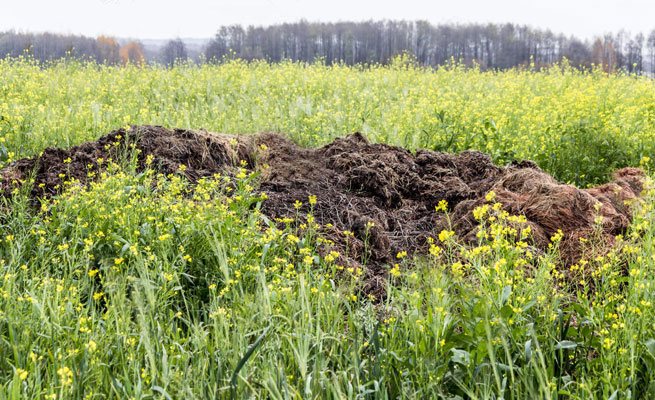
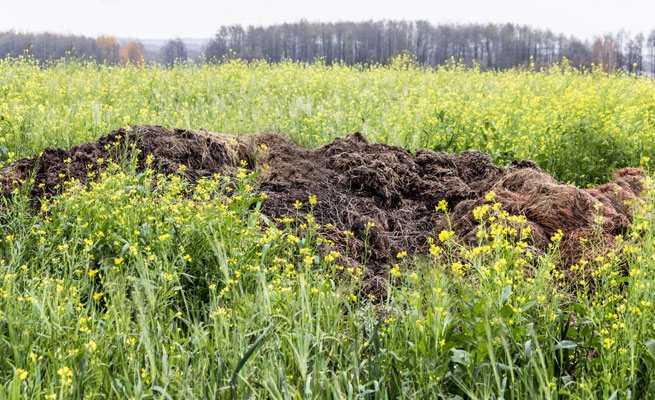
The disadvantages include:
- a huge volume – to replenish the same amount of minerals, hundreds of times more fresh manure or humus obtained from it will be required;
- the need for transformation into humus, because the latter is not only not toxic to plants, but also many times more effective as a complex fertilizer;
- the duration of the conversion of excrement into fertilizer;
- complexity of use – fertilizing with manure requires more steps and more time.
If we compare cattle excrement with the manure / droppings of other animals or birds, then in terms of overall usefulness for the garden it surpasses pig manure, comparable to the excrement of small ruminants (goats and sheep), and is also slightly inferior to horse manure.
Greenhouse manure
In greenhouse conditions, the use of manure as fertilizer should be more careful than in the open field. The greenhouse effect contributes to intensive decomposition with the release of gas and heat, so fresh manure can be applied only in the autumn for digging a ridge or in early spring to warm it up under a large layer of soil.
An ideal option for fertilizing the soil in a greenhouse is humus. This earthy mass no longer gives off heat, but makes the soil fertile, loose and soft.
Any manure is a source of pests and pathogenic microorganisms, greenhouse conditions are ideal for their development. Therefore, before planting plants, it is necessary to process the fertilized soil:
- pickled seeds spread out in the greenhouse will help get rid of the bear;
- a weak solution of potassium permanganate heated to 60 degrees (1 g per 10 liters) destroys many pests, they spill soil before planting;
- spraying the top layer of soil and greenhouse walls with copper sulfate eliminates fungus, mold, moss.
Horse manure is used to warm up the soil after wintering. It reheats quickly and heats up well. From it, together with sawdust and straw, make the bottom layer of the ridge. Then 25 cm of earth is poured on top and spilled with hot water, covered with foil. After 7 days you can start planting.
How long does it take to get humus
To get ready-made high-quality organic fertilizer from humus, you can use several methods.
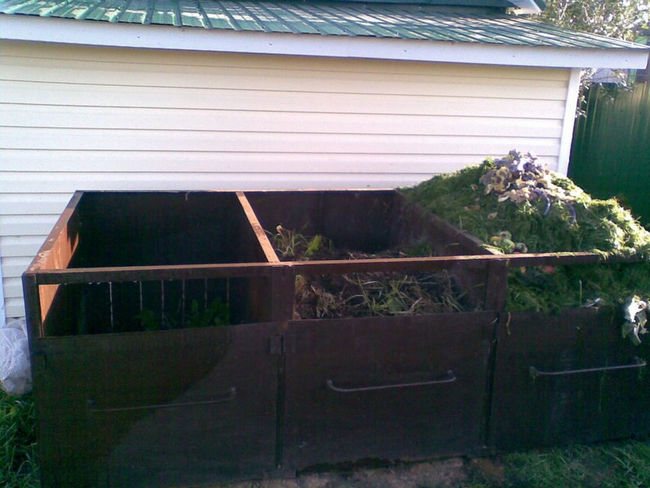

As mentioned earlier, if you use the usual scheme for obtaining humus, then the process of decay can take several years. If we resort to a more intensive technology, when organic matter for decay is placed in an insulated container or pit, then after 5-6 months you can get a first batch of humus.
Thus, a definite connection can be traced here between the optimal conditions for the development of beneficial microorganisms and the speed of the decay process. By artificially increasing the temperature and humidity of the air in the compost pit, you can significantly speed up the process of obtaining high-quality fertilizer from humus. The process of obtaining humus is similar to obtaining compost, see if this fertilizer will suit you better.

